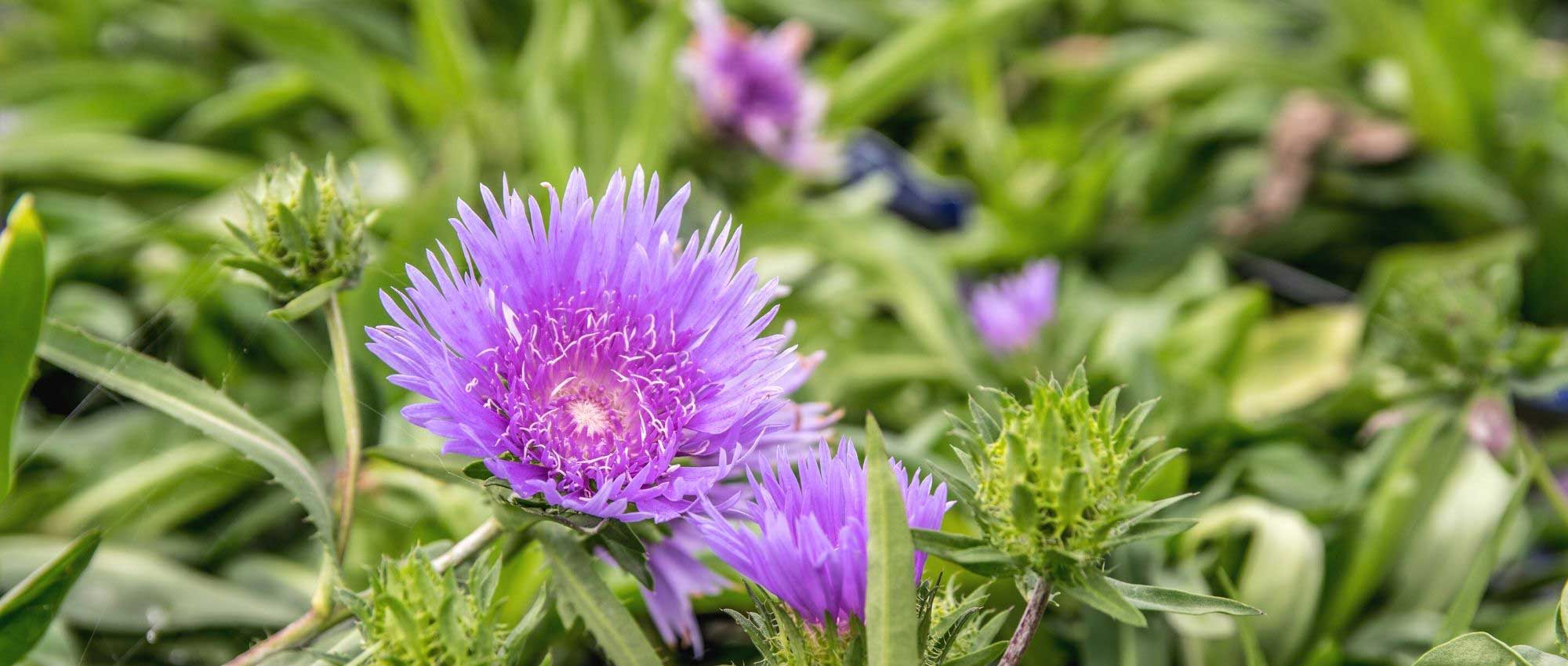
Stokesia: planting, cultivation, and care
Contents
Stokesia in a nutshell
- Stokesia is a lovely perennial that offers a long flowering period, from July to October!
- It bears large heads of blue, mauve, white, or yellow flowers, resembling those of cornflower.
- It is a little-known plant, rarely cultivated in gardens.
- It thrives in full sun, in cool, well-draining, rather acidic soil, and is particularly sensitive to stagnant moisture in winter.
- It easily finds its place in naturalistic gardens!
A word from our expert
The Stokesia laevis is a perennial plant appreciated for its fluffy flower heads, reminiscent of those of cornflowers or centaureas. It is still an underappreciated plant, too rarely cultivated in gardens. Native to China, it has naturalized in the United States, earning it the nicknames Chinese Aster and American Cornflower. The flowers are most often blue or mauve, but they can also be white, and even yellow! There are indeed some beautiful varieties: from the blue flowers of Stokesia laevis ‘Blue Star’, the deep purple flowers of ‘Purple Parasols’, the white flowers of Stokesia ‘Traumerei’, and the yellow flowering of Stokesia ‘Mary Gregory’, you are sure to find varieties that you will love!
Stokesia thrives in full sun but also tolerates partial shade, although flowering may be slightly less abundant. It is particularly sensitive to winter moisture, which can cause its roots to rot, so it requires well-draining soil. Nevertheless, it is quite an adaptable and vigorous plant. When happy, Stokesia can self-seed! It can be propagated by sowing or by division of clumps.
Discover all our tips for successfully growing it in the garden: which variety to choose, where to plant it, how to care for and propagate it, and which plants to associate it with…!
Botany
Botanical data
- Latin name Stokesia laevis
- Family Asteraceae
- Common name American Bluebell, Chinese Aster
- Flowering from July to October
- Height generally between 30 and 50 cm
- Exposure full sun
- Soil type cool, well-drained, rather acidic
- Hardiness between -15 and -20 °C
Stokesia is a perennial plant native to China, which has naturalised in the southeastern United States, where it grows in coniferous woods. It is also sometimes found in wooded clearings, marshes, wet environments, and ditches. Due to its origin and its head-like flowers, it is commonly referred to as the American Bluebell or Chinese Aster. Stokesia laevis is the only species in the genus, but there are many varieties. It is a rather rare plant in cultivation, but it deserves to be more frequently present in gardens!
Stokesia was named in honour of the English botanist and physicist Jonathan Stokes (1755-1831), who became known for his work on the use of foxglove to treat heart failure.
Stokesia belongs to the (very) large family of Asteraceae, which includes nearly 33,000 species. This family encompasses very common and appreciated garden plants: daisies, bluebells, asters, daisies, sunflowers, yarrow, echinacea, heleniums… These plants are characterised by their inflorescences in heads, which resemble a single large flower, while in reality, they consist of a multitude of small flowers!
Stokesia forms clumps of fairly dense leaves, above which solitary flowers rise in summer. Depending on the varieties, they measure between 20 cm for the smallest and 60 cm for the tallest… even up to 1 m high for the variety ‘Omega Skyrocket’.
Stokesia flowers for quite a long time, from July until October. With its flowers grouped in heads, it is typically an Asteraceae. What we think is a flower is actually a multitude of small flowers grouped together! Where one might expect to see a petal, it is actually a complete flower. The heads are formed of external ligulate florets (which resemble a petal) and central tubular florets. The external ligules are fringed and deeply divided, giving the flower its tousled appearance. The heads of Stokesia measure 5 to 10 cm in diameter and are inserted on a collar of green, dentate bracts, which are very decorative. They are solitary and borne above the foliage on erect stems.

The flowering of Stokesia comes in various soft shades, depending on the varieties! Stokesia ‘Mary Gregory’, ‘Purple Parasols’, and ‘Traumerei’
The flowers of Stokesia resemble those of the Bluebell or Centauries: the shades are similar, and the heads also bear cut ligules, which give this tousled appearance. This is indeed what earns it the nickname American Bluebell.
The botanical species Stokesia laevis has blue flowers, but depending on the varieties, they can be blue, mauve, white, and even yellow, as seen in Stokesia ‘Mary Gregory’. The centre of the flower is often a lighter shade, sometimes almost white, or occasionally a more pronounced hue. The flowering is melliferous: it attracts bees and butterflies that come to consume the nectar.
The flowers of Stokesia are also perfect as cut flowers for making bouquets! They have good vase life.
You must wait at least two months after flowering for the seeds to reach maturity. They are enclosed in capsules: dry dehiscent fruits that open when ripe to release the seeds.
The leaves of Stokesia are quite ordinary, yet decorative, forming a beautiful mass of dense foliage. They measure 15 to 20 cm long, are lanceolate and elliptical, with a lovely dark green hue. They are marked by a pretty central vein that is lighter, almost white. The lamina is quite thick and leathery. The leaves generally bear small thorns at the base of the lamina. The leaves are evergreen, thus remaining decorative even in winter.
Stokesia has fairly thick roots, which can be propagated by cuttings at the end of winter.

The leaves of Stokesia, slender and elongated (photo David J. Stang), and the dentate bracts surrounding the head
The main varieties of Stokesia
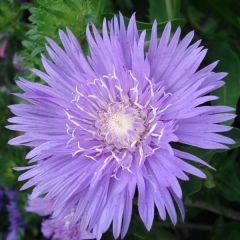
Stokesia laevis Purple Parasols
- Flowering time September to November
- Height at maturity 35 cm
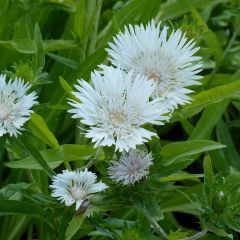
Stokesia laevis Traumerei
- Flowering time September to November
- Height at maturity 40 cm
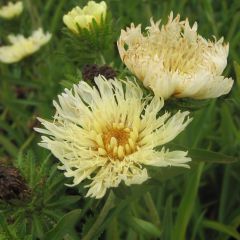
Stokesia laevis Mary Gregory
- Flowering time September to November
- Height at maturity 40 cm
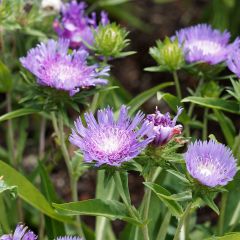
Stokesia laevis Blue Star
- Flowering time August to November
- Height at maturity 60 cm
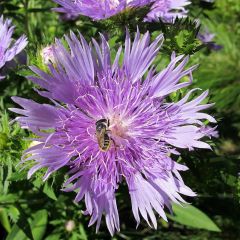
Stokesia laevis Elf
- Flowering time August to October
- Height at maturity 20 cm
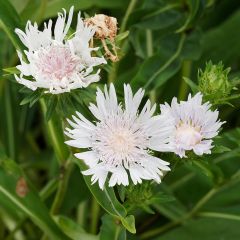
Stokesia laevis Alba
- Flowering time August to November
- Height at maturity 45 cm
Discover other Stokesia
View all →Available in 0 sizes
Available in 1 sizes
Available in 1 sizes
Available in 1 sizes
Available in 1 sizes
Available in 1 sizes
Available in 1 sizes
Planting
Where to Plant Stokesia?
Stokesia prefers full sun, but it can also tolerate partial shade. A sunny exposure encourages flowering, while in partial shade, the flowers may be fewer.
Stokesia enjoys relatively cool, yet well-drained soils. It is sensitive to stagnant moisture in winter, which could cause its roots to rot… Therefore, it is important to avoid heavy, suffocating soils! Feel free to add gravel or coarse sand before planting. It likes light soils that are fairly rich in humus, somewhat acidic, but it also accepts neutral soils. Avoid planting it in calcareous ground.
When to Plant?
You can plant Stokesia in autumn or spring. If you live in a rather cool and damp region, or if your soil is heavy, prefer spring planting. In the south, or in well-draining soil, we recommend planting in autumn.
How to Plant?
If you are installing several Stokesia plants, we advise maintaining a distance of 30 to 40 cm between them.
- Dig a planting hole that is two to three times the size of the root ball.
- Feel free to add gravel or coarse sand to improve drainage, mixing it with garden soil and replacing it in the planting hole.
- Remove the Stokesia from its pot and plant it.
- Fill the hole by placing substrate around it, then firm it down with the palm of your hand.
- All that’s left is to water generously.
Continue to water regularly in the weeks following planting, until it is well established, using rainwater if possible.
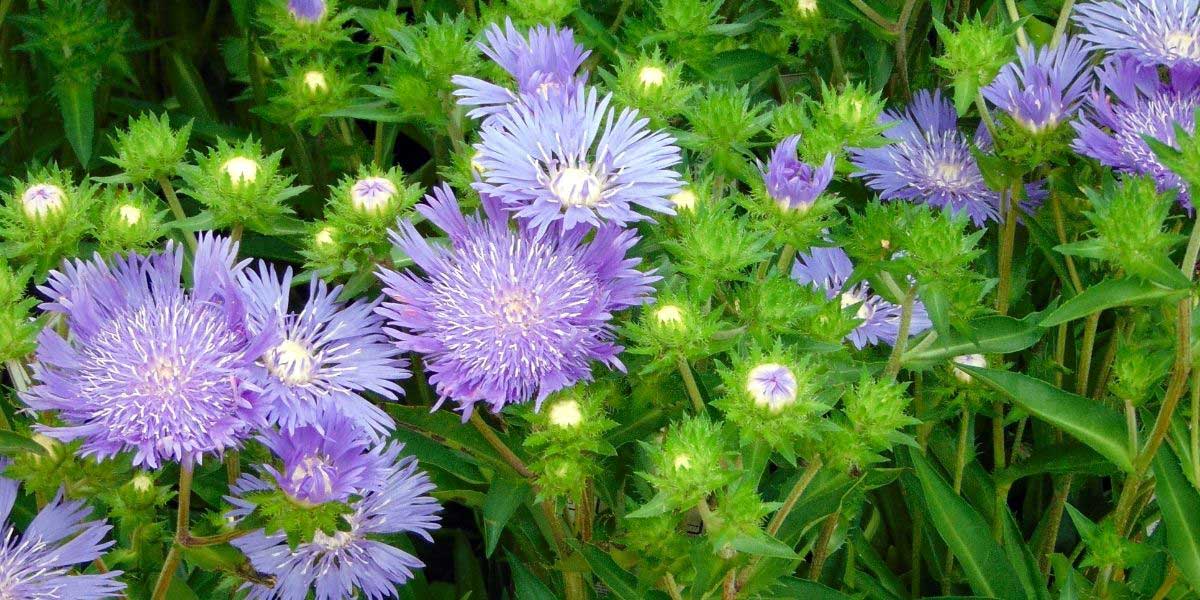
Stokesia laevis ‘Mels Blue’
Entretien
Once established, Stokesia requires little maintenance. It is a fairly resilient plant that tolerates drought well and is not prone to diseases or pests.
We recommend removing faded flowers as you see them, cutting them at the base of the stem. In addition to the aesthetic aspect, this will encourage the appearance of new flowers, prolonging the flowering period. However, if you wish to collect seeds for sowing, you can leave a few faded flowers to allow them to produce seeds.
Feel free to harvest the flowers to create cut flower arrangements. They hold up quite well in a vase.
If you are growing Stokesia in a pot, remember to water it regularly, as the substrate dries out much faster than in the ground! Preferably use rainwater, as tap water may be too hard for it.
If you live in a cold region, do not hesitate to apply a thick layer of mulch around the clump in autumn to protect it from the cold.
Multiplication
You can propagate Stokesia by sowing seeds or dividing clumps. It is also possible to propagate from roots at the end of winter, but this technique is less commonly used.
Sowing
Sow Stokesia seeds in early spring or in autumn under a cold frame.
- Fill pots with special seed compost, level the surface, and lightly firm it down.
- Sow the Stokesia seeds by scattering them on the surface.
- Cover them with a very thin layer of compost, as they need light to germinate.
- Water gently.
- Cover with plastic film to maintain a humid atmosphere.
- Place the pot in a bright location, ideally with a temperature between 18 and 20 °C.
- Ensure the substrate remains slightly moist until the seeds germinate. If it dries out, the germination process will be halted.
Stokesia seeds generally take 2-3 weeks to germinate, sometimes up to 5 weeks.
You can plant the young plants in the garden after the last frosts.
Division of Clumps
Dividing has the advantage of rejuvenating clumps and giving them more space. It is an interesting technique when they become too old and dense. Stokesia can be divided every 3 to 4 years in spring.
- Identify a well-established and vigorous clump that has been in place for several years.
- Carefully dig it up, digging wide enough not to damage the roots.
- Separate it into several sections.
- Replant them in a new location after carefully preparing the soil, then water generously.
Association
With its soft-hued flowers reminiscent of cornflowers, Stokesia is ideal for a naturalistic garden! To accompany it, favour airy and light blooms with a free habit. We particularly recommend asters, Gauras, Verbena bonariensis, Echinacea purpurea, sages (for example, Salvia pratensis), Eryngiums… Also consider incorporating grasses, whose fine foliage and light spikes will enhance the “wild meadow” style. You might choose Stipa pennata, Stipa tenuifolia, Pennisetum…
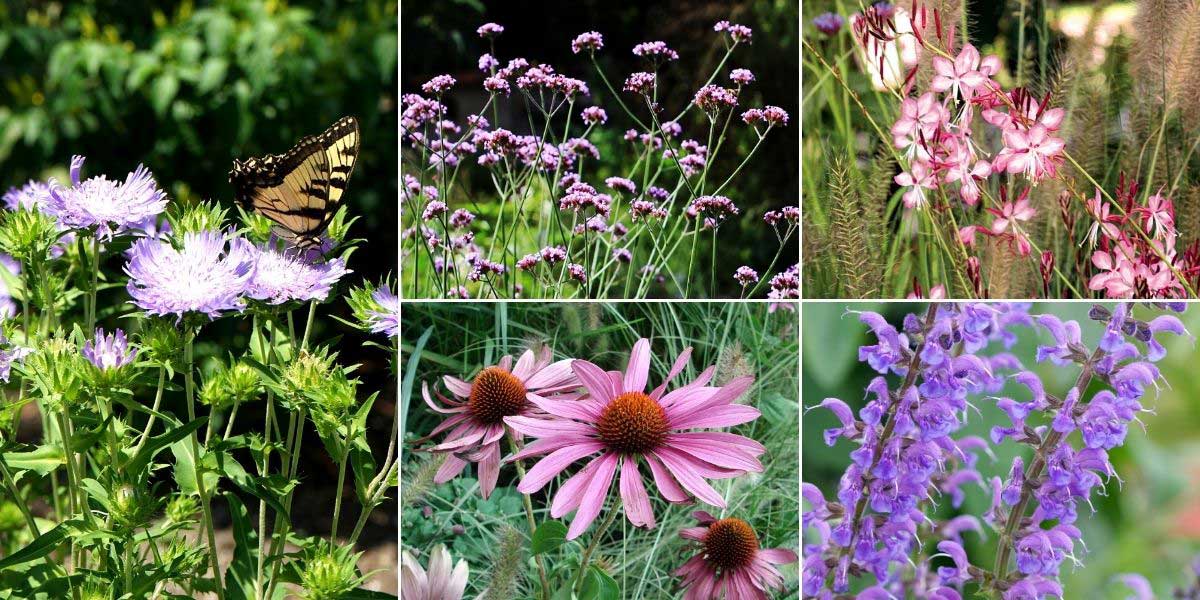
Stokesia is ideal in a naturalistic garden, alongside other airy and free-flowering plants. Stokesia laevis (photo John Winder), Verbena bonariensis (photo Karelj), Gaura lindheimeri ‘Rosy Jane’ and Pennisetum, Echinacea purpurea ‘Prairie Splendor’ and Salvia pratensis ‘Rhapsody in Blue’
Stokesia will also find its place in a cottage garden or English garden. Plant it alongside Japanese anemones, foxgloves, sages, and roses. Integrate blooms in soft hues and pastel colours: blue, mauve, soft pink, apricot, orange… Place alongside them some plants with opulent foliage to create a sense of lushness: ferns, giant hostas, Astilboides tabularis, acanthus, Cynara cardunculus…
You can also create a stunning summer border with brightly coloured flowers, such as gaillardias, rudbeckias, daylilies, coreopsis, crocosmias… We recommend taking the opportunity to play with colour contrasts by using complementary colours on the colour wheel. For example, pair the blue flowers of Stokesia ‘Blue Star’ with orange blooms! This will add a lot of depth to your border. Consider using agastache ‘Kudos Mandarin’, crocosmia ‘Carmine Brillant’, Echinacea ‘Big Kahuna’, or California poppy. Also enhance the blue of Stokesia with other flowers of the same hue: agapanthus, nepeta, campanulas, sages…
You can also create beautiful floral compositions in pots, which you can place on your terrace.
Useful resources
- Discover our range of Stokesia
- Subscribe!
- Contents































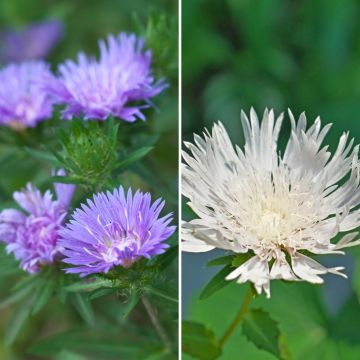






Comments